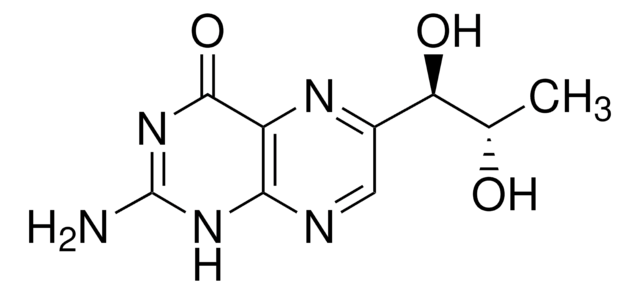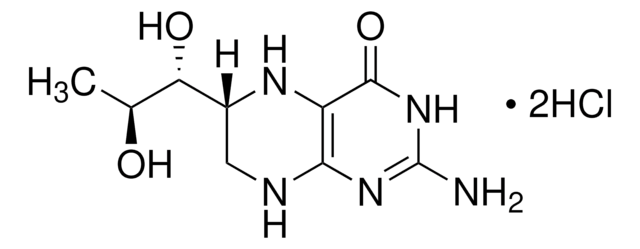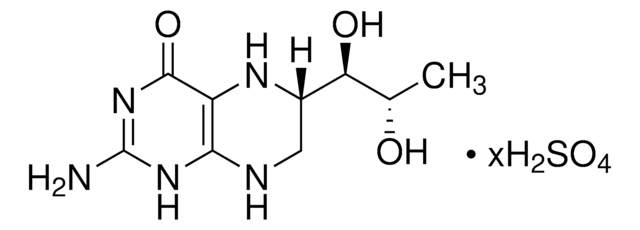37272
7,8-Dihydro-L-biopterin
≥94% (HPLC)
Sinonimo/i:
2-amino-6-(1,2-dihydroxypropyl)-7,8-dihydro-3H-pteridin-4-one
About This Item
Prodotti consigliati
Saggio
≥94% (HPLC)
Temperatura di conservazione
−20°C
Stringa SMILE
C[C@@H](O)[C@@H](O)C1=NC2=C(NC1)N=C(N)NC2=O
InChI
1S/C9H13N5O3/c1-3(15)6(16)4-2-11-7-5(12-4)8(17)14-9(10)13-7/h3,6,15-16H,2H2,1H3,(H4,10,11,13,14,17)/t3-,6-/m1/s1
FEMXZDUTFRTWPE-AWFVSMACSA-N
Applicazioni
- A Landscape of Metabonomics for Intermingled Phlegm and Blood Stasis and Its Concurrent Syndromes in Stable Angina Pectoris of Coronary Heart Disease.: This study by Zheng et al. (2022) explores the metabolic profiles associated with phlegm and blood stasis syndromes in patients with stable angina pectoris. The research highlights the role of various metabolites, including 7,8-Dihydro-ʟ-biopterin, in the pathophysiology of these syndromes, suggesting potential diagnostic and therapeutic targets (Zheng et al., 2022).
- Three-dimensional structure of human tryptophan hydroxylase and its implications for the biosynthesis of the neurotransmitters serotonin and melatonin.: Wang et al. (2002) present the crystal structure of human tryptophan hydroxylase, providing detailed insights into the enzyme′s interaction with cofactors such as 7,8-Dihydro-ʟ-biopterin. This structural information is crucial for developing drugs targeting neurotransmitter biosynthesis pathways (Wang et al., 2002).
Codice della classe di stoccaggio
11 - Combustible Solids
Classe di pericolosità dell'acqua (WGK)
WGK 3
Punto d’infiammabilità (°F)
Not applicable
Punto d’infiammabilità (°C)
Not applicable
Dispositivi di protezione individuale
Eyeshields, Gloves, type N95 (US)
Certificati d'analisi (COA)
Cerca il Certificati d'analisi (COA) digitando il numero di lotto/batch corrispondente. I numeri di lotto o di batch sono stampati sull'etichetta dei prodotti dopo la parola ‘Lotto’ o ‘Batch’.
Possiedi già questo prodotto?
I documenti relativi ai prodotti acquistati recentemente sono disponibili nell’Archivio dei documenti.
I clienti hanno visto anche
Il team dei nostri ricercatori vanta grande esperienza in tutte le aree della ricerca quali Life Science, scienza dei materiali, sintesi chimica, cromatografia, discipline analitiche, ecc..
Contatta l'Assistenza Tecnica.















